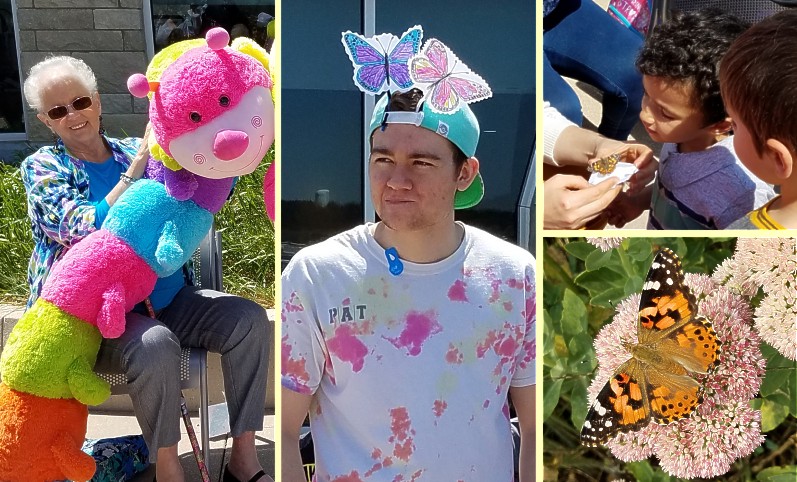Kansas Snapshots by Gloria Freeland - May 11, 2018
Monarchs over Manhattan
The April 29 Butterfly Release Party at Manhattan’s Flint Hills Discovery Center had been on my calendar for a long time. But when
the day came, I considered not going because it was cloudy and windy.
Then I thought about how much I’ve always loved butterflies, especially the bright black and orange monarchs and painted ladies that
are common in Kansas. So at about 1:30, I headed to the center for the 2 p.m. release.
The party was a celebration of the last day of the Rainforest Adventure exhibit and Butterfly House. During the exhibits’ three-month duration,
the center sponsored various children’s activities, such as a butterfly bingo game, butterfly crafts and the “pollinator pursuit”
game, where children learned about honeybees and pollination.
By the time I arrived, a crowd of about 350 had gathered, including many children with their parents. I spotted friends Sue and Kay
and asked them to save me a place while I paid for admission.
By the time I climbed the steps to the rooftop terrace, they had settled on a spot on a low limestone wall. I suggested that we sit
on the floor along with the kids. Kay laughed and said someone would have to get a crane to get us back up!
The weather took a turn for the better. The sun came out and the wind died down a bit, making it fun to just sit and observe. One
little girl had butterfly wings attached to her back. A man wore a hat with paper butterflies on it. A family cuddled with a giant
stuffed caterpillar like one of the items to be given away at the conclusion of the event.
As we waited for the release to start, parents tried to rein in their toddlers. The excitement of the older children was palpable.
Some of the butterflies to be released had been ordered as caterpillars, while others were purchased as adults. Earlier in the day,
some of the children had helped capture the three dozen butterflies from their “tent” in the discovery center. They would be the
lucky ones to release them, although one disappointed youngster complained, “There aren’t enough butterflies.”
Staff members from the center, Sunset Zoo and Blueville Nursery made a few announcements about the monarchs and what kinds of plants
help nurture them on their annual migration.
According to monarchwatch.org:
Each fall, hundreds of millions of monarch butterflies migrate from the United States and Canada to overwintering areas in Mexico and
California where they wait out the winter until conditions favor a return flight in the spring. The monarch migration is truly one
of the world's greatest natural wonders, yet it is threatened by habitat loss in North America - at the overwintering sites and
throughout the spring and summer breeding range ... To offset the loss of milkweeds and nectar sources, we need to create, conserve,
and protect milkweed/monarch habitats.
It said the use of herbicides on crops, pastures and roadsides; the development of subdivisions, factories and shopping centers;
genetically-modified crops; and climate change have contributed to declining habitats for the monarchs. The numbers have decreased
significantly over the past 20 years, but the public can help by planting milkweed and other nectar sources for them.
As 2 p.m. approached, some of the captured monarchs and painted ladies fluttered inside glass jars while others were held captive in
triangular paper cages. Instructions were given to parents to help their children release the butterflies without injuring them.
As the children or parents opened the jars or carefully unwrapped the paper triangles, we all looked skyward. Some of the butterflies
flew off right away while others rested on their liberators’ hands for several minutes before taking flight.
As we watched, we yelled and clapped. Sue later said there weren’t that many butterflies, but “like raindrops in Kansas - each and
every one of them got a big hand.”
One staff members said the center had recently been named a Monarch Waystation. Stephen Bridenstine, the center’s curator of
education, later told me:
Our existing native landscaping that encircles our building met all the requirements for the Monarch Waystation program.
That means we have the correct milkweed plants as well as nectar plants and the proper shelter. I assume other sites are purpose
built and designed to meet these specifications, but our landscaping hosting native Flint Hills plants already met all the
requirements. In other words, it wasn't designed for the Waystation program, but fit the bill anyway!
Monarchs travel a long distance for their migration ... The Flint Hills with its native tall-grass prairie is a critical location
along their north-south migration patterns. It provides crucial nectar sources and milkweed for reproduction. Manhattan is a perfect
locale to support a Monarch Waystation and we’re proud to be the newest station.
I may have a head start on helping the butterflies on their migration. Last September, I was excited to see dozens of painted ladies
on the sedum plants near our house and mailbox.
I wasn’t sure how they were related to monarchs, but after looking online, I found that both belong to the nymphalid or brush-footed
family of butterflies. Both are migratory species.
One of the signs in the Flint Hills Discovery Center’s rainforest exhibit discussed the “soaring spirits” of the monarch. Since the
monarchs arrive in Mexico in time for All Saints Day - Nov. 1 - some people believe the butterflies represent the souls of the dead.
All I know is I’m glad I made it to the butterfly release party. On what had started as a cloudy, windy day, it certainly made my
spirit soar to see the monarchs over Manhattan.
